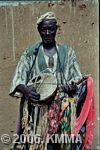



The during is a one-string fiddle of the Frafra. In the literature it is referred to as duding (M. Schottner 1993 p. 81) and durunga (J. Cogdell Dje Dje 1980 p.5). The Dagomba call a similar fiddle gonje. The one-string fiddle is found in the Sudan savannah belt of West Africa. The during consists of half of a round gourd covered with an aluminium sheet containing a sound hole. The neck of the fiddle is an arched stick that passes right through the gourd. The string is made of horsehair and is secured at the back to the fibre tailpiece, and at the front to the neck via the bridge. The during is played using a metal bow. The instrument is tuned at the back by means of a wooden pin attached between the gourd and the tailpiece.
Components of the during:
The during is nearly always accompanied by a gourd rattle, or siyarik. On some occasions the women often dance to this music.
The Frafra during playing technique differs in tempo, phrasing and virtuosity from the gonje music of the Dagomba and the Mamprusi. The bowing technique requires a lighter touch and is more sophisticated and more rhythmic. The during musicians use typical harmonization while accompanying their own songs, with few ostinato figures. The music is mostly homophonic in texture, but in some passages it can also be heterophonic. In contrast with the instrumental accompaniment, the singing part is very repetitive. The musician uses rhythmic patterns, transposing them up or down within the modal tone system. The playing technique of the left hand is wholly based on producing harmonics, or flageolet notes. The musician plays with the tips of his fingers because on a monochord with a horsehair string the harmonics are very close together in relation to the fundamental note. The during can be played in various instrumental settings: solo, accompanied by a siyarik gourd rattle or as part of an ensemble with other fiddles. Usually the women 'ululate' with their tongue while listening to during music.
The during musicians belong to a caste of griots, musicians that can be compared to the gonje and the lunsi of the Dagomba. They perform at court or during ceremonies and funerals and also to entertain people in pito bars.
© RMCA/Dominik PHYFFEROEN